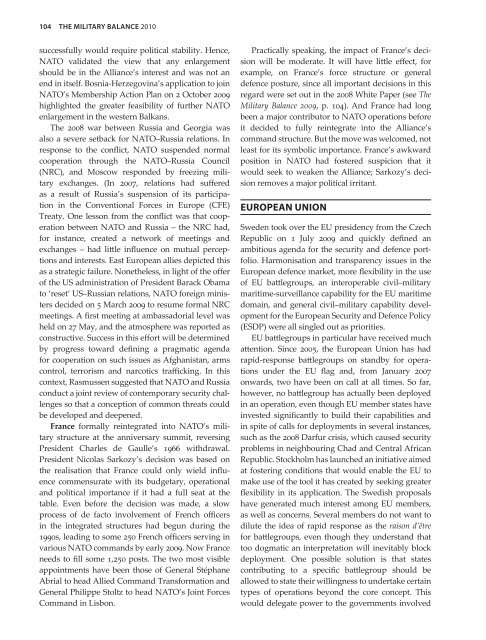You also want an ePaper? Increase the reach of your titles
YUMPU automatically turns print PDFs into web optimized ePapers that Google loves.
104 ThE MiliTary BalancE 2010<br />
successfully would require political stability. Hence,<br />
NATO validated the view that any enlargement<br />
should be in the Alliance’s interest and was not an<br />
end in itself. Bosnia-Herzegovina’s application to join<br />
NATO’s Membership Action Plan on 2 October 2009<br />
highlighted the greater feasibility of further NATO<br />
enlargement in the western Balkans.<br />
The 2008 war between Russia and Georgia was<br />
also a severe setback for NATO–Russia relations. In<br />
response to the conflict, NATO suspended normal<br />
cooperation through the NATO–Russia Council<br />
(NRC), and Moscow responded by freezing military<br />
exchanges. (In 2007, relations had suffered<br />
as a result of Russia’s suspension of its participation<br />
in the Conventional Forces in Europe (CFE)<br />
Treaty. One lesson from the conflict was that cooperation<br />
between NATO and Russia – the NRC had,<br />
for instance, created a network of meetings and<br />
exchanges – had little influence on mutual perceptions<br />
and interests. East European allies depicted this<br />
as a strategic failure. Nonetheless, in light of the offer<br />
of the US administration of President Barack Obama<br />
to ‘reset’ US–Russian relations, NATO foreign ministers<br />
decided on 5 March 2009 to resume formal NRC<br />
meetings. A first meeting at ambassadorial level was<br />
held on 27 May, and the atmosphere was reported as<br />
constructive. Success in this effort will be determined<br />
by progress toward defining a pragmatic agenda<br />
for cooperation on such issues as Afghanistan, arms<br />
control, terrorism and narcotics trafficking. In this<br />
context, Rasmussen suggested that NATO and Russia<br />
conduct a joint review of contemporary security challenges<br />
so that a conception of common threats could<br />
be developed and deepened.<br />
France formally reintegrated into NATO’s military<br />
structure at the anniversary summit, reversing<br />
President Charles de Gaulle’s 1966 withdrawal.<br />
President Nicolas Sarkozy’s decision was based on<br />
the realisation that France could only wield influence<br />
commensurate with its budgetary, operational<br />
and political importance if it had a full seat at the<br />
table. Even before the decision was made, a slow<br />
process of de facto involvement of French officers<br />
in the integrated structures had begun during the<br />
1990s, leading to some 250 French officers serving in<br />
various NATO commands by early 2009. Now France<br />
needs to fill some 1,250 posts. The two most visible<br />
appointments have been those of General Stéphane<br />
Abrial to head Allied Command Transformation and<br />
General Philippe Stoltz to head NATO’s Joint Forces<br />
Command in Lisbon.<br />
Practically speaking, the impact of France’s decision<br />
will be moderate. It will have little effect, for<br />
example, on France’s force structure or general<br />
defence posture, since all important decisions in this<br />
regard were set out in the 2008 White Paper (see The<br />
Military Balance 2009, p. 104). And France had long<br />
been a major contributor to NATO operations before<br />
it decided to fully reintegrate into the Alliance’s<br />
command structure. But the move was welcomed, not<br />
least for its symbolic importance. France’s awkward<br />
position in NATO had fostered suspicion that it<br />
would seek to weaken the Alliance; Sarkozy’s decision<br />
removes a major political irritant.<br />
EUROPEAN UNION<br />
Sweden took over the EU presidency from the Czech<br />
Republic on 1 July 2009 and quickly defined an<br />
ambitious agenda for the security and defence portfolio.<br />
Harmonisation and transparency issues in the<br />
European defence market, more flexibility in the use<br />
of EU battlegroups, an interoperable civil–military<br />
maritime-surveillance capability for the EU maritime<br />
domain, and general civil–military capability development<br />
for the European Security and Defence Policy<br />
(ESDP) were all singled out as priorities.<br />
EU battlegroups in particular have received much<br />
attention. Since 2005, the European Union has had<br />
rapid-response battlegroups on standby for operations<br />
under the EU flag and, from January 2007<br />
onwards, two have been on call at all times. So far,<br />
however, no battlegroup has actually been deployed<br />
in an operation, even though EU member states have<br />
invested significantly to build their capabilities and<br />
in spite of calls for deployments in several instances,<br />
such as the 2008 Darfur crisis, which caused security<br />
problems in neighbouring Chad and Central African<br />
Republic. Stockholm has launched an initiative aimed<br />
at fostering conditions that would enable the EU to<br />
make use of the tool it has created by seeking greater<br />
flexibility in its application. The Swedish proposals<br />
have generated much interest among EU members,<br />
as well as concerns. Several members do not want to<br />
dilute the idea of rapid response as the raison d’être<br />
for battlegroups, even though they understand that<br />
too dogmatic an interpretation will inevitably block<br />
deployment. One possible solution is that states<br />
contributing to a specific battlegroup should be<br />
allowed to state their willingness to undertake certain<br />
types of operations beyond the core concept. This<br />
would delegate power to the governments involved


